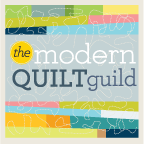Wash your fabric first - especially if you are piecing your quilt. I like to serge my fabric's raw edges before throwing it into the washer - it only takes a little time, and I get to use my serger - sergers are so cool. And, there is the added benefit that the serged edge will not unravel in the washer and dryer and become a tangled up mess of fray. I try to take my fabric out of the dryer while it is still damp so it will iron nicely; but if not, I give it a quick spritz with the mist-er to take out any pressed folds.
 Squaring up basically involves lining up the weft, selvedge to selvedge weave, of your fabric. When manufacturers bolt up fabric (I think I just made up that action) there is no guarantee that the grain is running straight on the weft - actually you can be fairly certain it is not straight. Take a look at this piece of fabric, off the bolt, out of the laundry, ironed flat, and folded selvedge to selvedge lining up the quilt shop's cut edge.
Squaring up basically involves lining up the weft, selvedge to selvedge weave, of your fabric. When manufacturers bolt up fabric (I think I just made up that action) there is no guarantee that the grain is running straight on the weft - actually you can be fairly certain it is not straight. Take a look at this piece of fabric, off the bolt, out of the laundry, ironed flat, and folded selvedge to selvedge lining up the quilt shop's cut edge.  See the big wavy wrinkle at the bottom of the fold - this is telling you your fabric is not on grain - that the weft is not aligned. Here's the close up of the wrinkle. You simply cannot properly cut fabric without aligning the grain.
See the big wavy wrinkle at the bottom of the fold - this is telling you your fabric is not on grain - that the weft is not aligned. Here's the close up of the wrinkle. You simply cannot properly cut fabric without aligning the grain. Now, by simply shifting the alignment of the selvedge edges, you can align the weft as seen below, and the wrinkle disappears. See how by shifting the top fold of the fabric to the right I have aligned the weft. The slice of fabric to the left is waste.
Now, by simply shifting the alignment of the selvedge edges, you can align the weft as seen below, and the wrinkle disappears. See how by shifting the top fold of the fabric to the right I have aligned the weft. The slice of fabric to the left is waste. To make rotary cutting the fabric easier, fold the fabric again - bottom fold to selvedge - being certain that you maintain the weft alignment. If you are working with a piece of fabric larger than a yard, worry only about squaring up about 1 yard at a time. Here's the fabric folded and ready to cut.
To make rotary cutting the fabric easier, fold the fabric again - bottom fold to selvedge - being certain that you maintain the weft alignment. If you are working with a piece of fabric larger than a yard, worry only about squaring up about 1 yard at a time. Here's the fabric folded and ready to cut. Before going at the fabric with your rotary cutter glide your hand over the bottom fold to make certain there are no wrinkles of fabric in the fold. I need a hand model - my family says I have oddly small hands - until I pull in the big bucks, you're stuck with my hand.
Before going at the fabric with your rotary cutter glide your hand over the bottom fold to make certain there are no wrinkles of fabric in the fold. I need a hand model - my family says I have oddly small hands - until I pull in the big bucks, you're stuck with my hand. Now you can line up your ruler - I like to use my 12 1/2 inch square ruler for this cut - it really stabilizes the fabric for the cut. Your first cut is to trim off the waste - the fabric that doesn't align.
Now you can line up your ruler - I like to use my 12 1/2 inch square ruler for this cut - it really stabilizes the fabric for the cut. Your first cut is to trim off the waste - the fabric that doesn't align. You now have a nice, straight, squared piece of fabric to start cutting.
You now have a nice, straight, squared piece of fabric to start cutting. Here is the waste fabric from either end of my yardage.
Here is the waste fabric from either end of my yardage. I basically lost over 2 inches of fabric. Now if this was a quarter yard cut, I'd have only 7 usable inches of fabric, not 9 inches. I rarely buy quarter yards for this very reason. When you are buying fabric take a close look at the fabric weave - if it looks really off, ask the merchant to try to square it up.
I basically lost over 2 inches of fabric. Now if this was a quarter yard cut, I'd have only 7 usable inches of fabric, not 9 inches. I rarely buy quarter yards for this very reason. When you are buying fabric take a close look at the fabric weave - if it looks really off, ask the merchant to try to square it up.  I was making 1 1/2 inch cuts on my squared fabric. After cutting about a yard, I opened my edge to see if I still had a straight edge - don't expect to - fabric is just too flexible, and our cuts just too "off" despite our best effort, to maintain a consistent grain. You can see below that my cut is off - my edge is no longer straight. Take the time to square it up again. If you rotary cut a lot, you can feel the difference in cutting fabric on grain from fabric off the grain - pay close attention next time you are doing a lot of cutting.
I was making 1 1/2 inch cuts on my squared fabric. After cutting about a yard, I opened my edge to see if I still had a straight edge - don't expect to - fabric is just too flexible, and our cuts just too "off" despite our best effort, to maintain a consistent grain. You can see below that my cut is off - my edge is no longer straight. Take the time to square it up again. If you rotary cut a lot, you can feel the difference in cutting fabric on grain from fabric off the grain - pay close attention next time you are doing a lot of cutting.  Here is my waste again.
Here is my waste again. Some fabric shops will rip the fabric - fabric rips on the straight grain. Yes, you will end up purchasing a piece of fabric already on grain, but the edge will be very distorted - you are going to need to trim this distortion away - taking the edge back at least 1/2 to 1 inch.
Some fabric shops will rip the fabric - fabric rips on the straight grain. Yes, you will end up purchasing a piece of fabric already on grain, but the edge will be very distorted - you are going to need to trim this distortion away - taking the edge back at least 1/2 to 1 inch. It's worth the time and effort to square your fabric. Working with fabric that has not been squared will distort your quilt - and you will likely end up with "issues" - everyone hates "issues". BTW - I love this beautiful fabric from Kaffe Fassett - funny, since I started posting I have been working with a lot of Kaffe fabric - very unusual for me.
It's worth the time and effort to square your fabric. Working with fabric that has not been squared will distort your quilt - and you will likely end up with "issues" - everyone hates "issues". BTW - I love this beautiful fabric from Kaffe Fassett - funny, since I started posting I have been working with a lot of Kaffe fabric - very unusual for me.


















3 comments:
Very interesting post!! I always square up but am not a prewasher. Hmmm- might need to rethink that. ~Christine
Some quilt shops rip the fabrics to make them square. That is fine on solids. The ripped edge can pull threads and ruin the print on the surface of the fabrics. Squaring up is an important of garment making also. If it isn't straight it will hang funny. Great tutorial for doing this. Chris
Great info and makes it easier to understand how to "square" up my fabric. Thanks!
Post a Comment